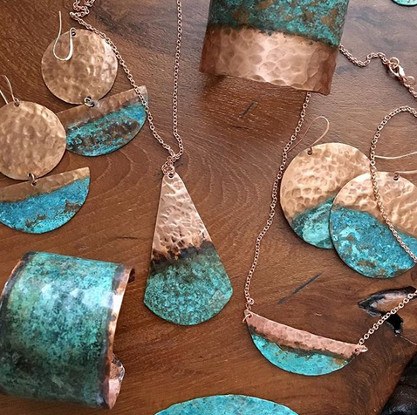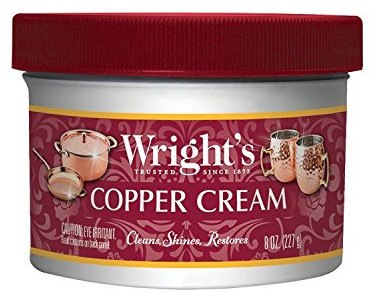Copper jewelry can be a challenge to clean. Improper technique can lead to staining and irreparable damage. In this article, we'll review some of the most popular methods of safely cleaning copper jewelry. We'll also discuss preemptive measures you can take to combat tarnishing.
About Copper
Copper has been used in the manufacturing of jewelry for more than 10,000 years. Today, it's often utilized as a base material in gold plated jewelry. It's sometimes even mixed with real gold to make it more resilient. Stylish and affordable, copper jewelry is a great choice if you're trying to look good on a budget. It's also 100% recyclable, which has made it a favorite among eco-friendly crowd.
But despite its many benefits, copper has its fair share of drawbacks. Perhaps the most notable of these drawbacks is its tendency to lose its luster. Over time, copper tarnishes and becomes visually unimpressive when compared to gold and silver. In many cases, patina develops. Patina is a green layer which engulfs copper jewelry that has not been adequately cared for. Jewelers sometimes intentionally allow patina to develop. This is because it can be shaped to create a unique and appealing design on copper jewelry. But without a professional hand to mold it, patina is unsightly and must be removed entirely.

How to Prevent Tarnish
Sealing is a popular way to minimize tarnishing in copper jewelry. It also slows the development of patina. In some cases, sealing totally eradicates the risk of patina. Sealing is done using specialized wax or polish and it's most effective when performed by a professional jeweler.
Many jewelers sell copper jewelry already sealed, although it's not always a guarantee. When purchasing copper jewelry, always ask the seller if the piece has been sealed. If it hasn't already been sealed, then you may want to pay extra to have it sealed before leaving the shop. We understand that you probably wouldn't want to spend more money immediately after buying new jewelry. However, sealing will likely save you money in the long run. With sealed copper jewelry, you are less likely to have to pay for repairs or cleanings.
DIY Copper Cleaning Methods
Some people choose to have their copper jewelry professionally cleaned. However, professional cleaning is usually expensive and is rarely necessary. There are a number of DIY methods you can use to clean your copper jewelry at home. We'll review some of the most effective methods below.
Baking Soda and Lemon Juice
Lemon juice is one of the most commonly used ingredients in DIY copper cleaning formulas. It's generally paired with an additional substance. In this method, that additional substance is baking soda.
Begin by mixing equal amounts of baking soda and lemon juice together to create a fine paste. Use your fingers to spread this paste across your copper jewelry before thoroughly rinsing it and leaving it to dry. If a deep clean is necessary, then you can use a toothbrush rather than your fingers to brush your jewelry with the paste. This method is best reserved for extravagant pieces of copper jewelry. It's particularly effective in cleaning jewelry with crevices and indentations.
Salt and Lemon Juice
There are different methods for using salt and lemon juice and below we will examine two methods. Just note that lemon juice is not recommended for jewlery with gemstones.
Method #1
This method isn't effective in ridding copper jewelry of patina. However, it's a reliable means of restoring a piece of copper that has lost its shine. Rather than mixing the salt and lemon juice together, begin by briefly soaking your copper jewelry in the lemon juice itself. Once you've done this, sprinkle a small amount of salt onto the surface of the jewelry and wait about five minutes. Next use a dry cloth (preferably cotton) to gently remove the salt from the jewelry. Once it has dried, your jewelry will shine as brightly as it did when you first bought it.
Method #2
Unlike the previous technique, this one calls for the salt and lemon juice to be mixed together. Dip your piece of copper jewelry in the solution and let to soak for a few minutes. Next remove the jewelry from the bowl and rinse it thoroughly to remove any excess salt which may have stuck to it. It's important to remember that a metal container should not be used to hold the salt and lemon juice solution. Instead, you should use a glass or ceramic bowl.
Ketchup
This method is a little unorthodox, but there are plenty of copper jewelry owners who swear by it. The acid in the ketchup can remove copper oxide, which is the dark outside layer that formed onto the copper. Begin by squeezing a small amount of regular tomato ketchup onto your copper jewelry. Use your fingers to massage the ketchup into the piece. Continue to do this, adding more ketchup if necessary, until all blemishes have been eradicated. You can then rinse off the ketchup.
Some people are understandably reluctant to use their fingers to spread ketchup across their jewelry. If you would like to avoid getting your hands dirty, then it's possible to use a toothbrush instead. If you decide to go that route then it's essential that you choose a toothbrush with soft bristles. Hard bristles may scratch your jewelry. Once the process has been completed, thoroughly rinse your jewelry under lukewarm water.
Salt and Vinegar
Vinegar is often used in the cleaning of copper jewelry. Begin by placing your jewelry into a bowl filled with vinegar, water and salt. You'll need a couple teaspoons of salt and a couple tablespoons of vinegar. Allow your jewelry to soak for 15 to 20 minutes before removing it and thoroughly rinsing it. When your jewelry has been cleaned, you can leave it out to dry or wipe it down using a cotton cloth. This method is not advised for jewelry containing gemstones as they can be damaged by the acid of the vinegar.
Commercial Copper Cleaning Solution
If you would rather avoid the DIY methods mentioned above, then there are a number of commercial copper cleaning products for you to consider. Our top recommendation is Wright's Copper Cream.
This product is great to use on copper cookware and jewelry. It provides a deep clean in seconds and can be easily applied and removed. Although it's slightly more expensive than many other commercial copper cleaners, the results are longer lasting.
Conclusion
When copper jewelry is properly maintained, its beauty can rival that of gold and silver jewelry. Unfortunately, copper stains easily. Regular cleaning is necessary to remove tarnish. The DIY cleaning methods outlined above are effective. Using generic household items, you can return tarnished copper to its former glory. Just remember that acidic substances may cause damage to gemstones. If your copper jewelry contains gemstones of any kind, then cleaning solutions with vinegar or lemon juice should be avoided.

